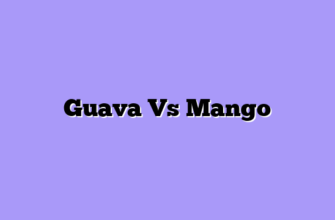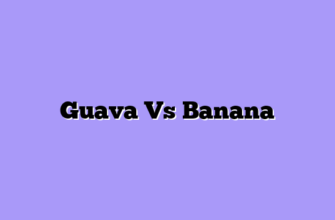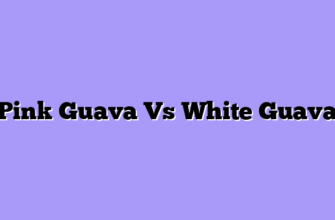Guava and Guanabana are both tropical fruits with distinct flavors and textures. Guava, a small, round fruit with a sweet and slightly tart flavor, is often eaten raw or used in jams and juices. Guanabana, also known as soursop, is a large, spiky fruit with a creamy, custard-like texture and a sweet, tangy flavor. It is often used in smoothies, ice cream, and desserts.
Taste and Texture
Guava, with its smooth, thin skin, reveals a flesh that ranges in color from pale yellow to deep pink, depending on the variety. The texture of guava is typically firm and slightly grainy, reminiscent of a pear. Its flavor is sweet and tangy, with a subtle floral note. Some varieties, like the strawberry guava, exhibit a more pronounced sweetness and a hint of strawberry aroma. The flavor of guava can be further enhanced by its high vitamin C content, which contributes to its refreshing and slightly tart taste.
Guanabana, on the other hand, presents a more complex sensory experience. Its spiky, green exterior conceals a creamy, white flesh that is studded with black seeds. The texture of guanabana is soft and custard-like, with a slightly fibrous consistency. Its flavor is a unique blend of sweet and tart, with hints of citrus, pineapple, and even a touch of vanilla. The sweetness of guanabana is often described as subtle and delicate, while its tartness adds a refreshing counterpoint.

Beyond their individual characteristics, guava and guanabana can also be combined to create unique flavor profiles. The sweet and tangy guava complements the subtle sweetness and tartness of guanabana, resulting in a harmonious blend of flavors. This combination is often found in tropical fruit salads, where the contrasting textures and flavors create a delightful sensory experience.
In conclusion, guava and guanabana offer distinct taste and texture experiences that cater to diverse palates. Guava’s firm, slightly grainy texture and sweet, tangy flavor make it a versatile fruit for various culinary applications. Guanabana’s soft, creamy texture and unique blend of sweet and tart flavors provide a more indulgent and exotic experience. Whether enjoyed individually or combined, these tropical fruits offer a delightful journey for the senses.
Nutritional Value
Guava and guanabana, both tropical fruits, offer a unique blend of flavors and nutritional benefits. While they share some similarities, their distinct profiles set them apart in terms of their nutritional value.
Guava, a small, round fruit with a sweet and tangy flavor, is a powerhouse of vitamin C. In fact, a single guava can provide more than twice the daily recommended intake of this essential vitamin, which plays a crucial role in boosting immunity and protecting against cell damage. Guava is also a good source of dietary fiber, which aids digestion and promotes satiety. Additionally, it contains potassium, a mineral essential for maintaining healthy blood pressure and muscle function.
Guanabana, also known as soursop, is a larger, heart-shaped fruit with a creamy, slightly acidic flavor. It is particularly rich in antioxidants, including vitamins C and E, which help combat free radicals and protect against chronic diseases. Guanabana is also a good source of folate, a B vitamin crucial for cell growth and development. Furthermore, it contains a significant amount of fiber, which contributes to digestive health and blood sugar regulation.
While both fruits are rich in vitamin C, guanabana boasts a higher concentration of this nutrient compared to guava. This makes guanabana a more potent source of antioxidants, which can help protect against oxidative stress and inflammation. However, guava surpasses guanabana in terms of potassium content, making it a better choice for individuals seeking to maintain healthy blood pressure.
In terms of fiber content, both fruits are comparable, offering a significant amount of this essential nutrient. Fiber is crucial for digestive health, promoting regular bowel movements and preventing constipation. It also helps regulate blood sugar levels and promotes a feeling of fullness, which can aid in weight management.
While both guava and guanabana offer a range of nutritional benefits, their distinct profiles make them suitable for different dietary needs. Guava, with its high vitamin C and potassium content, is an excellent choice for boosting immunity and maintaining healthy blood pressure. Guanabana, on the other hand, with its abundance of antioxidants and folate, is a valuable addition to a diet focused on protecting against chronic diseases and supporting cell growth. Ultimately, the choice between these two tropical fruits depends on individual preferences and dietary goals.
Culinary Uses
Guava’s versatility shines in its ability to be enjoyed in both sweet and savory preparations. Fresh guava is a delightful snack, offering a burst of sweetness with a refreshing tang. Its firm texture makes it ideal for slicing and adding to salads, providing a contrasting sweetness to savory ingredients. Guava’s tartness also makes it a popular ingredient in jams and jellies, where its flavor is intensified through the cooking process. Guava paste, a concentrated form of the fruit, is a staple in many Latin American cuisines, used as a filling for pastries, a topping for desserts, or a flavoring agent in sauces. In savory dishes, guava’s tartness can balance the richness of meats and seafood, adding a unique dimension to traditional recipes.
Guanabana, with its creamy texture and distinctive flavor, is primarily used in sweet preparations. Its pulp, which is often described as having a custard-like consistency, is a popular ingredient in desserts. Guanabana ice cream, a refreshing treat, captures the fruit’s unique flavor and creamy texture. The pulp is also used in smoothies, milkshakes, and juices, adding a tropical twist to these beverages. Guanabana’s sweet and tangy flavor also makes it a popular ingredient in cakes, pies, and other baked goods. In some regions, guanabana is used to make a refreshing drink called “guanabana shake,” which is often enjoyed as a healthy and flavorful alternative to traditional sodas.
While guava and guanabana are both tropical fruits with distinct culinary uses, their nutritional profiles also differ. Guava is a rich source of vitamin C, dietary fiber, and antioxidants, making it a healthy addition to any diet. Guanabana, on the other hand, is known for its high content of vitamin B, potassium, and antioxidants. Both fruits offer a range of health benefits, making them valuable additions to a balanced diet.
Health Benefits
Guava, scientifically known as Psidium guajava, is a small, round fruit with a sweet and slightly tart flavor. It is rich in vitamin C, a potent antioxidant that supports immune function and collagen production. Guava also contains a good amount of dietary fiber, which aids digestion and promotes satiety. Furthermore, it is a source of potassium, a mineral essential for maintaining healthy blood pressure and muscle function.
- Guanabana, also known as soursop, is a larger, heart-shaped fruit with a creamy, slightly acidic flavor. It is renowned for its high antioxidant content, particularly its abundance of vitamin C and polyphenols. These compounds have been linked to various health benefits, including reducing inflammation, protecting against cell damage, and potentially lowering the risk of chronic diseases. Guanabana is also a good source of fiber, potassium, and B vitamins.
- While both guava and guanabana offer a range of health benefits, there are some key differences to consider. Guava is generally lower in calories and carbohydrates compared to guanabana, making it a suitable choice for individuals watching their weight. However, guanabana boasts a higher concentration of antioxidants, particularly acetogenins, which have been studied for their potential anticancer properties.
- In terms of culinary uses, guava is often enjoyed fresh, juiced, or incorporated into jams, jellies, and desserts. Guanabana, on the other hand, is typically consumed as a refreshing beverage or used in smoothies, ice cream, and other culinary creations.
- It is important to note that while both fruits offer potential health benefits, they should be consumed in moderation as part of a balanced diet. Individuals with specific health conditions or allergies should consult with a healthcare professional before incorporating guava or guanabana into their diets.
In conclusion, guava and guanabana are both nutritious tropical fruits with distinct characteristics and potential health benefits. Guava is a good source of vitamin C, fiber, and potassium, while guanabana is rich in antioxidants, particularly acetogenins. Ultimately, the choice between these fruits depends on individual preferences, dietary needs, and health goals. By understanding the unique properties of each fruit, individuals can make informed decisions about incorporating them into their diets for optimal health and well-being.
Growing and Availability
Guava and guanabana, both tropical fruits, share a similar origin and are often enjoyed for their unique flavors and nutritional benefits. However, their cultivation and availability differ significantly, influenced by factors such as climate, soil conditions, and market demand.
Guava, scientifically known as *Psidium guajava*, thrives in warm, humid climates and can tolerate a wide range of soil types. Its adaptability makes it a popular fruit in many tropical and subtropical regions, including the Caribbean, Southeast Asia, and parts of South America. Guava trees are relatively easy to grow and can produce fruit within a year of planting. This ease of cultivation, coupled with its high yield, has contributed to its widespread availability in many parts of the world.
Guanabana, on the other hand, known botanically as *Annona muricata*, is more sensitive to environmental conditions. It requires a warm, humid climate with ample rainfall and well-drained soil. While it can be grown in various tropical regions, its cultivation is more limited compared to guava. Guanabana trees take longer to mature and produce fruit, typically requiring three to five years. This, combined with its more specific growing requirements, has resulted in a more limited availability of guanabana compared to guava.
The availability of both fruits also varies depending on the season. Guava, with its shorter fruiting cycle, is generally available year-round in many regions. However, peak seasons for guava production can vary depending on the specific variety and location. Guanabana, with its longer fruiting cycle, has a more defined seasonality. It typically ripens during the summer months in tropical regions, with availability often limited to specific periods.
The market demand for both fruits also plays a role in their availability. Guava, with its widespread popularity and ease of cultivation, is readily available in many markets, both locally and internationally. It is often used in various culinary applications, from fresh consumption to jams, juices, and desserts. Guanabana, while gaining popularity for its unique flavor and health benefits, is still considered a niche fruit in many markets. Its limited availability and shorter shelf life have contributed to its higher price compared to guava.
In conclusion, while both guava and guanabana are tropical fruits with distinct flavors and nutritional profiles, their cultivation and availability differ significantly. Guava, with its adaptability and high yield, is more widely available and readily accessible in many parts of the world. Guanabana, with its more specific growing requirements and longer fruiting cycle, has a more limited availability, often restricted to specific seasons and regions. Despite these differences, both fruits continue to be enjoyed for their unique qualities and contribute to the diverse culinary landscape of tropical regions.
Q&A
**1. What is the difference in taste?**
Guava has a sweet and slightly tart flavor, while Guanabana has a creamy, sweet, and slightly tangy flavor with hints of pineapple and strawberry.
**2. What is the difference in texture?**
Guava has a firm, crisp texture, while Guanabana has a soft, creamy texture.
**3. What are the nutritional differences?**
Guava is rich in vitamin C, potassium, and fiber, while Guanabana is a good source of vitamin C, potassium, and antioxidants.
**4. What are the common uses?**
Guava is often eaten fresh, used in juices, jams, and desserts. Guanabana is typically eaten fresh, used in smoothies, juices, and ice cream.
**5. What are the differences in appearance?**
Guava is a small, round fruit with green or yellow skin. Guanabana is a large, heart-shaped fruit with a green, spiky skin.








